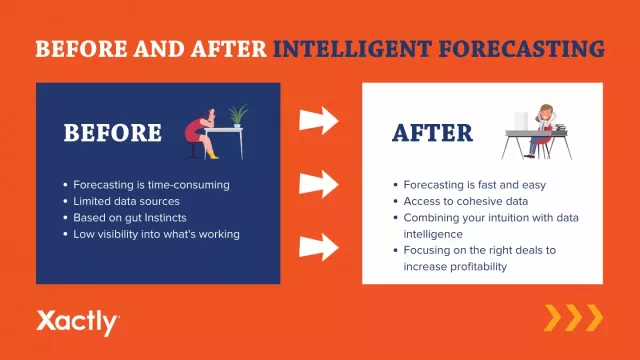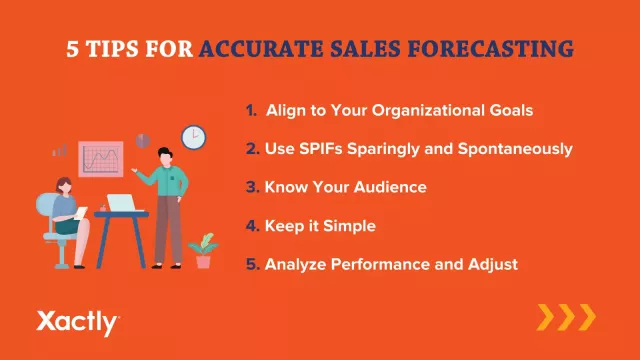
If you were to sit down with your sales leadership team and ask them what their number one, overarching goal as an organization was, I would bet my salary that they would say, “to hit or surpass their number, aka revenue goal.”
Delivering revenue predictability is essential for companies to accelerate their growth and guarantee future success. But, in order to be prepared for your company's future, you need to be able to accurately forecast what your sales are going to be.
When you forecast, you gain a clear picture of how much new revenue your company will generate in a given period of time and what resources it will take to get you there. It gives you the right data insights to take the necessary steps towards continuous growth.
BUT creating an accurate sales forecast is not a cakewalk. Predicting your sales over an extended period of time can be an arduous task due to a variety of factors. Even if you think your sales forecasts are on the money at the beginning of the year, you will never be 100 percent correct in the long run because of changing market conditions.
That’s why letting intelligent forecasting technology guide the sales process is the best way to make sure each and every sales forecast, and optimization thereafter, is as accurate and transparent as possible. Let’s take a quick look at what sales forecasting methods look like before and after implementing an intelligent forecasting solution:
Before Intelligent Forecasting:
Uh oh, it’s that time of year again - your annual sales forecast. Time to lock yourself in a conference room and spend countless days trying to create your sales projections for the upcoming fiscal year. If you’re managing your forecasting manually, it’s going to be an uphill battle to fix your revenue projections in any situation.
Leaders base their forecasts on “current” data and pretend that nothing in the next 365 days will change once the plan goes into effect. These plans are essentially based on limited data, gut instinct, and guesswork.
This puts you at a disadvantage because you have limited visibility into what’s working and what’s not, so you won’t know what to change or keep in your plan until the year’s over, potentially leaving a ton of money on the table since you weren't able to course-correct in real-time.
After Intelligent Forecasting:
Time to create your sales forecast? No problem! You’ve got the power of intelligent forecasting technology on your side. Now you can leverage data to eliminate assumptions, focus on the right opportunities, and drive greater revenue predictability and consistency across your entire organization.
Five Things You Could Be Doing NOW to Make Your Next Forecast More Accurate:
When it comes to putting together a game plan to make your next sales forecast more accurate, it really all comes down to a few key things. Here are a few tips:
1. Create a Flexible Process
Also known as, “expect the unexpected’” or “embrace the unknown.” Building elements of flexibility and adaptability into your forecasts is a sure-fire way to make sure you're optimizing your plans off the most current and reliable data. I mean, think about it, can you REALLY predict what’s gonna happen in Q4 in Q1 (*cough* remember 2020 *cough*)?
It’s best to use a clearly defined 12-month forecast, consistently monitor this to address any deviations, and refine your predictive sales forecasting by adjusting each quarter.
2. Enforce Pipeline Hygiene & Formalize Your Forecasting Processes
Having a formal and structured forecasting process can increase the win rates by up to 12.6 percent, according to the CSO Insights 5th Annual Sales Enablement Study. Ensuring information is accurate, up to date, and removing deals that don’t belong in the pipeline improve sales & revenue analytics immensely.
3. Be Realistic
Past performance is the best indicator for future success. You know how your company has performed historically; don’t set unrealistic numbers in stone. Unrealistic revenue projections or assumptions about how much growth you can achieve in one year can set you up for disaster: angry leadership, frustrated reps, misallocated resources, and inaccurate projections for future forecasts.
The solution? Gauge your expectations. Benchmark them to past performance and use intelligent software to help accurately assess achievable numbers for your year.
4. Don’t Put All Your Eggs In One Basket
Data-wise, of course. Don’t use one stagnant source of data to create your projections. If the data in your system is bad, your forecasting accuracy will be, too.
Odds are that if you based your plans off one data source, it’s probably siloed, meaning you could be missing out on bigger-picture info that could be housed somewhere else. One of the biggest mistakes a forecaster—or a decision-maker—can make is to over-rely on one piece of seemingly strong information because it happens to reinforce an idea or conclusion you have already reached.
There's no one set of numbers that represents the "truth" for your business. Use a solution that’s able to combine multiple datasets into one single view. That will make sure you have all the information you need at the tips of your fingers at any time.
5. Use Good Tools and Be Thorough
Gartner’s State of Sales Operations Survey reveals that only 45 percent of sales leaders and sellers have high confidence in their organization’s forecasting accuracy. This is where accurate and intelligent business forecasting software comes in.
Making sure that you have real-time automated visibility into deal changes is crucial in making sure your current plans are relevant and working in current market conditions. It's the difference between talking about what to do (proactive) and finding out what happened (reactive).
Tools like Xactly Forecasting are revenue-focused applications developed specifically for sales performance analysis. Because it is AI-enabled and can integrate with existing systems, it allows organizations to take a sledgehammer to internal roadblocks and open up your organization to the benefits of a revenue-focused strategy.
Automated, intelligent forecasting opens the door to more visibility and control over your revenue predictions. Having a formalized approach to forecasting enables your organization to look into things like trends in sales cycles, seller behavior, deal blockers, etc, in order to increase forecasting accuracy and improve revenue-driving strategies.
Sales Forecasting in 2021 and Beyond
To secure continued growth, organizations need to employ the right combination of tactics, technology, and data to their sales planning process. The easiest way to guarantee that is by utilizing intelligent business forecasting software.
To see how your organization can take advantage of sales automation and artificial intelligence to give you a consistent sales process and accurate revenue forecasts, download our guide, “Why a RevOps Mindset Depends on Accurate Sales Forecasting.”





